By Cynthia Reiners
Rocky Mountain penstemon, Penstemon strictus, is an attractive Colorado native perennial that meets several important objectives for a suburban native plant gardener. This species of penstemon is often commercially available, easily grown in a variety of micro-climates and ordinary soil, and visibly supports the local web of life. A less well- known characteristic is that the rosette of evergreen basal leaves also creates a very effective groundcover. Very importantly, it is not nibbled by my numerous rabbits!
The following discussion reflects my twenty years’ experience gardening in Denver, with a steep learning curve of growing and often killing a total of 17 penstemon species. I have found that the single most important factor for success when placing a penstemon in my garden is understanding the habitat and plant community in which that particular species naturally grows.
Geographic distribution of Rocky Mountain penstemon (P. strictus)
Colorado Flora, both Eastern and Western Slopes, 3rd Edition, by Weber and Wittman, 2001, describes the range and habitat as follows: “Tall plants of sagebrush, pinon-juniper, mountain-mahogany and relatively mesic mountain meadows…Common through-out the middle altitudes.” (page 356, Eastern Slope).
Native Plants for High-Elevation Western Gardens, by Busco and Morin, 2003, expands this description: “Southern Wyoming to Utah, New Mexico and Arizona at elevations of 6,000 to 10,000 feet; native in many habitats from pinyon-pine to spruce-fir communities, naturalized along roadsides and in disturbed areas. Zone 2.” (page 258)
I translate these descriptions as “This is a very cold hardy plant that grows in both dry (sagebrush) and moderately moist (meadows) micro-climates, probably tolerates some shade and organic matter in the soil (shrub and forest communities) and grows easily from scattered seed (disturbed areas).” These are very different cultural requirements than species growing either in short grass prairie, where companion grasses provide some shade once the penstemon has completed blooming, or in canyon country, baking amidst hot, dry rocks.
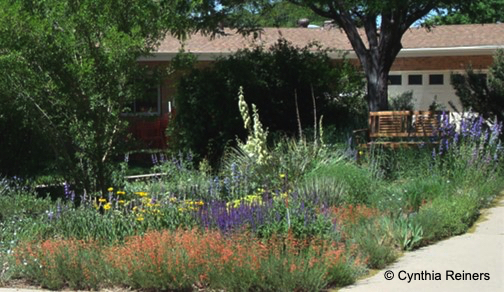
My east-facing dry garden contains various micro-climates, allowing me to plant groups of three or more P. strictus in three very different areas. Section 1, at the top of the slope adjacent to the driveway, receives the most rain run-off plus excellent drainage. The adjacent honey locust tree provides tolerable afternoon shade. (My test for whether a plant is receiving too much shade is two-fold: Does it bloom? And does it flop?).
Section 2 is at the bottom of the slope. Run-off does not flow that far, but a retaining wall collects rainfall and cold air, potentially creating “wet feet.”
Section 3 is in what I call the “extreme border”, adjacent to the hot reflective surfaces of the sidewalk, street and driveway, where the urban clay soil bakes to concrete. Run-off does not reach this section, but road splash, snow-blower loads and dogs are significant impacts. In this location, P. strictus in not directly adjacent to the sideway, but instead buffered by extensive P. pinifolius, Pine-leaf penstemon, one of the toughest and long-lasting plants in my garden.
P. strictus thrives in all three locations, although I did hand-water the Section 3 plants during the very hot and dry summer of 2018. The diameter of the flowers in the driest section was smaller than the other locations.
One micro-climate I would not plant this species in is the extremely sunny, hot, dry and windy section.
Plant description
Again, referencing Native Plants for High-Elevation Gardens:
“21/2ft H x 21/2ft W. Low green leaves form compact mat of medium texture… upright stems hold blooms along one side. Many tubular, 21/2in long, dark purple to brilliant blue-purple flowers… Blooms early to mid-summer.”

Wildlife value
BEES, BEES, BEES!
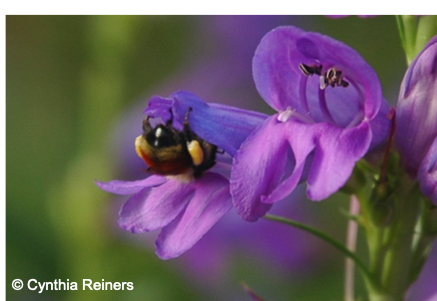
Very fortunately the garden bench and retaining wall each provide ready seating for extended observations. When the bees are flying it is quite a show.
Eurasian honey bees fly straight in and quickly back out. Small to medium size native bees curl themselves around the interior parts. Bumblebees are without a doubt the most impressive. They lean on the inner surface of the petals to maneuver their large bodies head-down in an entire 360o circle. I timed one individual staying in one flower for over five minutes.
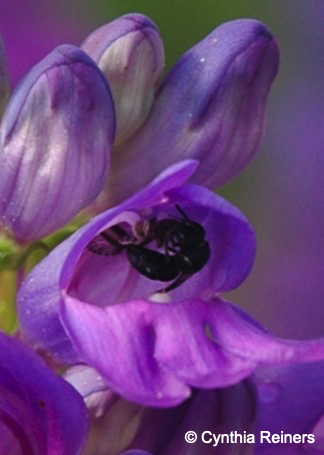
One of my very best wildlife observations ever came in the early summer of 2018, a famously hot and dry season. Two queen bumble bees, one tricolored, the other probably a yellow or two-spotted, came simultaneously to nectar at the same P. strictus plant in Section 1. They were huge, the size of the last segment of my thumb, and the separate flower stems bent almost to the ground under their weight. As I had never seen a queen of any bee species in the wild before, this was very special. I think the extra water and part shade received by that specific plant were important, resulting in the largest diameter flowers among all my P. strictus plants. I never saw queens elsewhere.
Some of my books reference P. strictus as attracting hummingbirds and butterflies to nectar, as well bees. I have not personally observed either, possibly because there are so many other flower choices more to their liking blooming at the same time.
Much more interesting, and not referenced anywhere that I have seen, is the importance of P. strictus as roosting habitat for a wide variety of insects. Because of the heat and drought, I changed my approach to cutting back spent flower stems. I have heard recommendations to cut back all stems the first year, and then in subsequent years all except the few desired for later seed collection, to help the plant instead direct its energy to growing roots and shoots.
In 2018, I left all of the stems up until the end of autumn in order to provide shade and protection from wind. I was very surprised at the number of species and number of individuals found roosting in the dried stems. Most numerous were the lady beetles, but I don’t have a good photo to share.

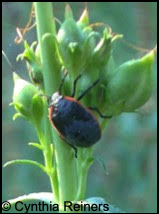
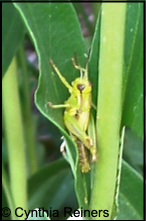
Roosting earwig, Roosting bug, and Roosting cricket
And here a is final view of the glorious winter color of the basal mat groundcover, as now we turn to green with the coming of spring.
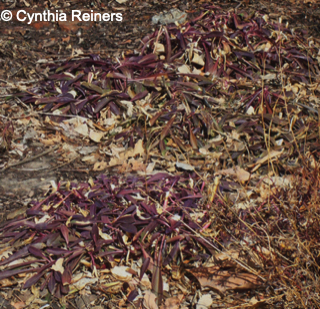
Attractive, available, adapted to horticulture, and important and interesting within the web of life…that’s why this is one of my favorite plants.
Curious to learn more about transforming your garden into a habitat with Colorado native wildflowers, grasses, shrubs, and trees? Check out our native gardening toolkit, register for an upcoming event, subscribe to our newsletter, and/or become a member – if you’re not one already!
